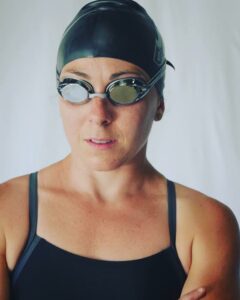Courtesy: Lainie Cassel
For the past ten years, I’ve worked one-on-one with hundreds of swimmers. From young kids looking to join their first club team to nationally-ranked collegiate athletes, I’ve seen it all. Across the variety of my clientele, I have found that many swimmers, no matter their age and even their ability, often struggle with the most basic concepts of how to move efficiently through the water.
I am sure there are many reasons for this, but I contribute most of the limitations to a few things:
- Despite many years of pushback against “garbage yardage”, many coaches still emphasize quantity over quality, especially in the younger groups, creating weak foundations and bad habits early on.
- Pools are often overcrowded, forcing kids to sacrifice body position in order to navigate busy lanes.
- The hyper-competitive nature of age-group swimming puts pressure on kids to swim fast, regardless of the cost it has to technique. This leads kids to racing one another during warm-ups, drills and sets meant to be slow rather than taking the time to focus on control, breath, and their body moving through the water.
The good news, however, is that by learning the fundamentals of body position and balance early on, swimmers have the ability for the most improvement long-term. Nobody is too young or too new for the fundamentals. I’ve taught these concepts to kids as young as five years old as well as those who have never swum competitively a day in their life.
What results is not only faster times, but more importantly, a stronger sense of body awareness, understanding, and control that will inevitably extend to their lives far beyond the water.
Below are some of the most glaring fundamentals I’ve seen hold swimmers back:
1) Side Balance
Solid body position starts with good balance; on our stomach, back and (especially) side. Lots of kicking on boards and rushed drill work means that some of the fastest young swimmers still struggle with the ability to stabilize while on their side.
2) Lack of Breath Awareness
Whenever I ask swimmers how they breathe in the water, they almost always jump to telling me about their breathing pattern. However, few are aware of how they inhale and exhale as they swim. Obviously, inefficient breathing can negatively impact oxygen intake resulting in premature fatigue, but it can also negatively impact body position by causing an unnecessary amount of tension in muscles that are more efficient when relaxed.
3) Weak Streamline
Despite being regularly coached on this, I am always surprised at how few swimmers are actually streamlining (and I mean really streamlining) off of every wall. Those with
consistently weak streamlines are not only slow off of the walls but they often create more frontal drag when they are swimming.
4) Eyes moving/Head Bouncing
If you are constantly looking around the pool while you swim, your head is probably moving and so too is your chest, hips, and legs. Maintaining an eye position that keeps your neck neutral and spine in alignment is crucial to good balance.
5) Overdependence on arms
A fast tempo is important for creating speed but not at the cost of body position. Overdependence on the arms can result in poor core engagement, excessive drag, arm fatigue and potential injury. During warm-ups, drills and slow swims, you should be able to move through the water with a slow tempo while still maintaining control through the rest of the body.
6) Swimming straight
When I coach, I am fortunate to have one swimmer per lane, allowing clients to swim back and forth in a straight line. Swimming straight is an important skill to develop in order to race more efficiently. If your team practices are often overcrowded, it might be worth practicing this skill on your own time. If you do so, try closing your eyes while you swim and start to notice where you veer off track.
7) Not using Hips and Glutes
Sitting throughout the school day can lead to tight hips and a butt that does not get used much. A lack of emphasis on the glutes during swim practice or dryland training results in sagged hips and a weak upkick. Glutes are best developed by dryland activities that focus on proper hinging technique as well as teaching kids how to incorporate them into their swim.
8) Poor ankle mobility
Besides causing a weak kick and excessive knee bend, poor ankle mobility affects how you balance in the water. Shoes and paved ground play a huge role in limiting foot strength and ankle mobility, so both should be worked on as often as possible. I prescribe exercises to athletes to do before practice, in the water between sets, and while watching television at home.
 ABOUT LAINIE CASSEL
ABOUT LAINIE CASSEL
Lainie Cassel is a swimming and strength and conditioning coach based in Atlanta, Georgia. She has coached at both the high school and NCAA level and is available for in-person private lessons as well as online training and video analysis. To find out more, visit her website: LainieCassel.com or follow her at instagram.com/LainieCassel.

